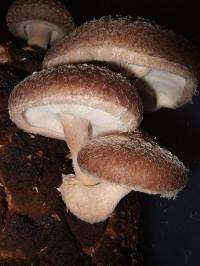Shiitake mushroom growing on wood. Image credit: Wikipedia.
(PhysOrg.com) -- Japanese farming folklore has it that lightning makes mushrooms multiply, and new research supports the idea. Mushrooms form a staple part of the diet in Japan, and the fungi are in such high demand that around 50,000 tons are imported annually, so scientists have been experimenting with artificial lightning to see if it could increase the crop.
A four-year study carried out at Iwate University in northern Japan on ten species of mushroom (so far) has shown that for eight of the 10 mushroom species a bolt of lightning-strength electricity could double the crop yield. The best improvements were found in the popular nameko and shiitake mushrooms. The experiments were carried out by seeding logs with mushroom spores and then applying high-voltage electricity pulses to the logs.
A direct hit by natural lightning would burn and kill mushrooms with up to a billion volts of electricity, so the researchers, led by Associate Professor of Engineering, Koichi Takaki, thought the increase in numbers of mushrooms, if it occurred at all, could be caused by exposure to a weakened charge that would travel through the soil after a nearby lightning strike. They therefore used less damaging pulses of electricity.
The experiments showed mushrooms react best when exposed to a ten-millionth of a second burst of electricity at 50-100,000 volts. Under the best conditions the nameko yield was 80% greater than the untreated control crop, while the shiitake crop yield doubled. Takaki said the mushrooms initially decrease the enzyme and protein secretions from the hyphae (tiny filaments that spread under the surface, acting like roots and giving rise to the fruiting bodies such as mushrooms), but then suddenly increase production.
The reason for the reaction is unknown and the subject of further investigations. One of the researchers, Yuichi Sakamoto of the Iwate Biotechnology Research Center, said it is possible the reaction is a response to danger, and the mushrooms react by giving themselves a reproductive boost and increase the number of fruiting bodies so their chance of survival is maximized.
Takaki and Sakamoto think the equipment they used could eventually be adapted for use by commercial mushroom growers.
The effects of artificial lightning are also being studied by Takaki’s team on daikon radishes, and by other researchers on beans, rapeseed plants and some lily varieties. So far the early results look promising.
© 2010 PhysOrg.com


















